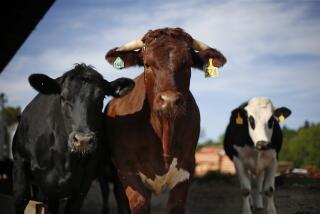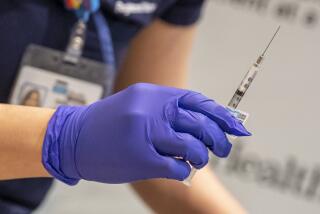Vaccines From Plants Mark a Breakthrough
- Share via
In a breakthrough that could help greatly reduce disease in developing countries, British and American researchers have developed a new technique for growing animal and human vaccines in plants.
The new approach, to be described next week at a meeting of the Royal Society in London, has the potential to cut the cost of vaccines and improve their safety and effectiveness. The result could be a vastly increased supply of inexpensive, easily storable vaccines.
Researchers at Purdue University and the John Innes Centre in Norwich, England, have added proteins from viruses that cause foot and mouth disease and AIDS to the cowpea mosaic virus, a common virus that infects plants producing black-eye peas. After being injected into young cowpea plants, the modified virus proliferates rapidly. Large quantities of the virus can then be easily harvested from the plants for use in vaccines.
Preliminary tests in guinea pigs have shown that the virus modified with foot and mouth disease proteins produces a strong immune response and protects the animals from infection. The virus modified with AIDS proteins also produces an immune response in mice, but mice do not develop AIDS so there is no way to tell if the response is protective.
Vaccines produced this way should be much safer than conventional vaccines, said Purdue virologist John E. Johnson, because the plant virus cannot infect human or animal cells and because no animal products that might contaminate a vaccine are used.
A foot and mouth vaccine based on the new technology could be on the market within five years, and the researchers are working on similar vaccines against hepatitis, the papilloma virus, which causes warts and cervical cancer, and the common cold, said Innes molecular biologist George Lomonossoff.
“This is a significant advance in several ways,” said plant virologist Roger Beachey of the Scripps Clinic and Research Foundation in La Jolla. “Its impact on the cost of vaccines and their availability to developing countries should make it a tremendous breakthrough.”
Several other research groups have been attempting to produce vaccines in the same manner, but the new studies, sponsored by Agricultural Genetics Co. of Cambridge, England, are the first report that modified viruses grown in plants will produce immunity in animals.
Many companies have been attempting to use genetic engineering techniques to produce vaccines, some successfully. The most common technique has been to identify one or more proteins in the target virus that stimulate production of protective antibodies, then produce those proteins in yeast, bacteria or animal cells.
One good example of this approach is the hepatitis B vaccine marketed by Merck Sharpe & Dohme and SmithKline-Beecham. Several animal vaccines, including one for foot and mouth disease, are produced this way, as are most AIDS vaccines under development.
But that approach presents several problems. Purification of the proteins is difficult and expensive. The hepatitis B virus costs the consumer $60 to $100 per dose, and three doses are required. There is also a risk, particularly for proteins grown in animal cells, that a virus may contaminate the vaccine.
Furthermore, the proteins used in such vaccines are typically small, compared to infectious viruses and bacteria, and do not stimulate the immune system strongly when administered by themselves. The vaccines must therefore contain what is known as an adjuvant, such as a killed tuberculosis virus, to stimulate the immune system into action.
Vaccine experts note that there are few effective adjuvants available for human use--the main reason why three doses of the hepatitis B vaccine are required.
The plant-virus technique provides a way around most of these problems. The virus grows in large quantities in the leaves of plants and can be readily extracted from the crushed leaves. One leaf provides enough virus to make 200 doses of foot and mouth vaccine, said Peter Barfoot, business development manager of Agricultural Genetics.
One gram of virus--comparatively speaking, a huge quantity--can be produced for only $50 by the new technique, compared to a cost of tens of thousands of dollars using conventional approaches.
Furthermore, the modified cowpea mosaic virus serves as its own adjuvant, thereby simplifying preparation of a vaccine and further reducing its cost.
Finally, Beachey said, plant viruses such as the cowpea mosaic virus are much more stable than animal viruses and can often be stored without refrigeration. Lack of refrigeration facilities for vaccines has been a major impediment to vaccination programs in developing countries.
More to Read
Sign up for Essential California
The most important California stories and recommendations in your inbox every morning.
You may occasionally receive promotional content from the Los Angeles Times.










